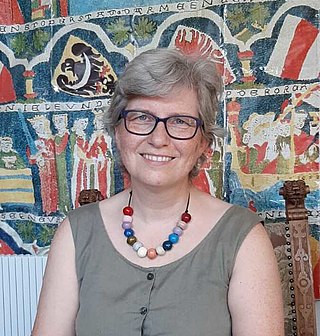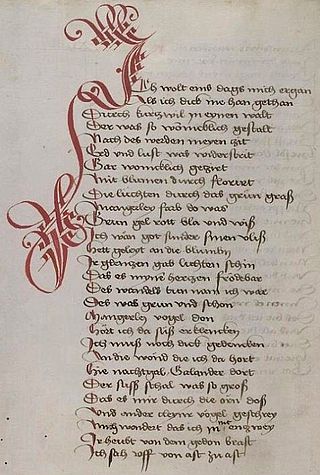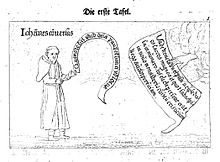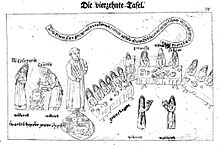
Baindt Abbey, otherwise the Imperial Abbey of Baindt, was a Cistercian nunnery in Baindt in the district of Ravensburg in Baden-Württemberg, Germany.

Lindow in der Mark, short: Lindow (Mark), is a town in the Ostprignitz-Ruppin district, in Brandenburg, Germany. It is located 14 km northeast of Neuruppin, and 29 km northwest of Oranienburg. The town is situated on an isthmus between the lakes Gudelacksee and Wutzsee.

Wienhausen Abbey or Convent near Celle in Lower Saxony, Germany, is a community of Evangelical Lutheran women, which until the Reformation was a Cistercian Catholic nunnery. The abbey owns significant artworks and artifacts, including a collection of tapestries and the earliest surviving example of a type of eyeglasses.
Ebstorf Abbey is a Lutheran convent of nuns that is located near the Lower Saxon town of Uelzen, in Germany.

Lüne Monastery is a former Benedictine nunnery in the Lower Saxon town of Lüneburg. Today it is a Protestant Lutheran convent and is managed by the Klosterkammer Hannover. The current abbess is Reinhild Freifrau von der Goltz.

"Gelobet seist du, Jesu Christ" is a Lutheran hymn, written by Martin Luther in 1524. It was first published in 1524 in the Eyn geystlich Gesangk Buchleyn. For centuries the chorale has been the prominent hymn (Hauptlied) for Christmas Day in German speaking Lutheranism, but has also been used in different translations internationally. It has appeared in hymnals of various denominations including the Catholic Church.

The Abbey of the Holy Cross in Rostock, Germany, was founded in the 13th century by Cistercian nuns. It is the only fully preserved abbey in the city. The complex includes the former abbey church which is used today as the University Church (Universitätskirche). The remaining former convent buildings house the Museum of Cultural History for the city of Rostock.
Agnes of Landsberg was a German noblewoman. She was the third child of Conrad II (1159–1210), Margrave of Lusatia, and his wife, Elisabeth, the daughter of Mieszko III the Old (1126–1202), Duke of Poland. She was a daughter-in-law of Henry the Lion.

Henrike Lähnemann is a German medievalist and holds the Chair of Medieval German, University of Oxford. She is a Fellow of St Edmund Hall, Oxford.

Geisenfeld Abbey was a convent in Bavaria, Germany, in the town of Geisenfeld. It was founded in 1037 and dissolved in 1804. At one time it was one of the most prosperous convents in Bavaria.

The Birgittenkloster is a Bridgettine convent in Bremen, Germany, founded in October 2002. The first convent to be founded in Bremen since the Reformation, it has adopted an ecumenical role in line with the teachings of Saint Bridget.
Himmelpforten Convent was founded as a monastery of nuns following the Cistercian Rule during the 13th century in Himmelpforten, in today's Lower Saxony, Germany. During the 16th century, it was converted into use as a Lutheran Damsels' Convent. The Himmelpforten Convent was founded before 1255 and finally dissolved in 1647. The convent complex was built between 1300 and 1330. After 1645 the buildings, including the abbey, increasingly decayed, until they were little by little demolished. The dilapidated abbey was demolished in 1737 and replaced by today's St. Mary's Church which partially covers the foundations of the former abbey.

Nigel Fenton Palmer FBA was a British Germanist and Professor Emeritus at the University of Oxford.
Rottenmünster Abbey, also the Imperial Nunnery of Rottenmünster, was a Cistercian abbey located near Rottweil in Baden-Württemberg. The self-ruling Imperial Abbey was secularized in the course of the German mediatization of 1802–1803 and its territory annexed to the Duchy of Württemberg. The monastery was closed in 1850. The buildings of the former abbey now house a hospital.

The Neuenwalde Convent is a Lutheran damsels' convent in Neuenwalde, a locality of Geestland, Lower Saxony, Germany.

Günterstal Abbey, earlier also Güntersthal Abbey, was a Cistercian nunnery that existed from 1221 to 1806 located in Günterstal, which today is a district in Freiburg im Breisgau, Germany.

St. Michaelis is one of the main churches in Lüneburg, Lower Saxony, Germany. It was first an abbey church of the former monastery of Benedictines, built from 1376 in brick Gothic style. It became Lutheran during the Reformation. Johann Sebastian Bach was for two years a pupil at the school of St. Michaelis.

The Hanover Monastic Chamber is a special authority based in Hanover within the scope of the Ministry of Science and Culture of Lower Saxony. It administers former ecclesiastical, mediatized property and maintains churches and convents. In addition, as a foundation body, it administers four independent foundations under public law.

The Monastery of Love (Das Kloster der Minne) is a Minnerede (courtly love story) or Minneallegorie (courtly love allegory) from the 2nd quarter of the 14th century. The poem consists of up to 1890 rhyming couplets and was probably composed between 1330 and 1350 in southern Germany. The author is unknown.




















